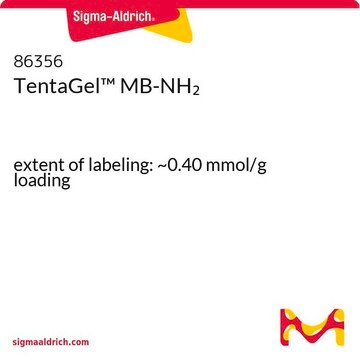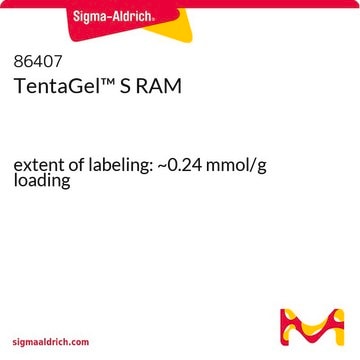91924
Tentagel™ M OH Microspheres
extent of labeling: ~0.2 mmol/g loading
Synonym(s):
O-(2-Hydroxyethyl)polyethylene glycol grafted to polystyrene
Sign Into View Organizational & Contract Pricing
All Photos(1)
About This Item
UNSPSC Code:
12352200
NACRES:
NA.25
Recommended Products
form
powder
extent of labeling
~0.2 mmol/g loading
particle size
10 μm
storage temp.
2-8°C
Application
Tentagel beads are functionalized polystyrene-polyethylene glycol (PS-PEG) beads that may be used in the development of combinatorial libraries for high throughput analysis.
Legal Information
TentaGel is a trademark of Rapp Polymere GmbH
Storage Class Code
13 - Non Combustible Solids
WGK
WGK 3
Flash Point(F)
Not applicable
Flash Point(C)
Not applicable
Personal Protective Equipment
dust mask type N95 (US), Eyeshields, Gloves
Certificates of Analysis (COA)
Search for Certificates of Analysis (COA) by entering the products Lot/Batch Number. Lot and Batch Numbers can be found on a product’s label following the words ‘Lot’ or ‘Batch’.
Already Own This Product?
Find documentation for the products that you have recently purchased in the Document Library.
H Weinberger et al.
Archiv der Pharmazie, 330(4), 109-111 (1997-04-01)
Peptides from small combinatorial libraries, covalently attached to polymeric TentaGel beads, can be directly sequenced using amino acid analysis. For libraries with restricted diversity, generated by the split-mix synthesis method, the amino acids on a selected single bead identified by
Gary L Juskowiak et al.
Journal of combinatorial chemistry, 10(5), 726-731 (2008-07-29)
Cysteine-rich peptides are valued as tags for biarsenical fluorophores and as environmentally important reagents for binding toxic heavy metals. Due to the inherent difficulties created by cysteine, the power of one-bead one-compound (OBOC) libraries has never been applied to the
Hyoung Gee Baek et al.
Journal of combinatorial chemistry, 11(1), 91-102 (2008-12-09)
The one-bead one-compound (OBOC) combinatorial library method enables the rapid generation and screening of millions of discrete chemical compounds on beads. Most of the OBOC screening methods require the library compounds to remain tethered to the bead during screening process.
Our team of scientists has experience in all areas of research including Life Science, Material Science, Chemical Synthesis, Chromatography, Analytical and many others.
Contact Technical Service







